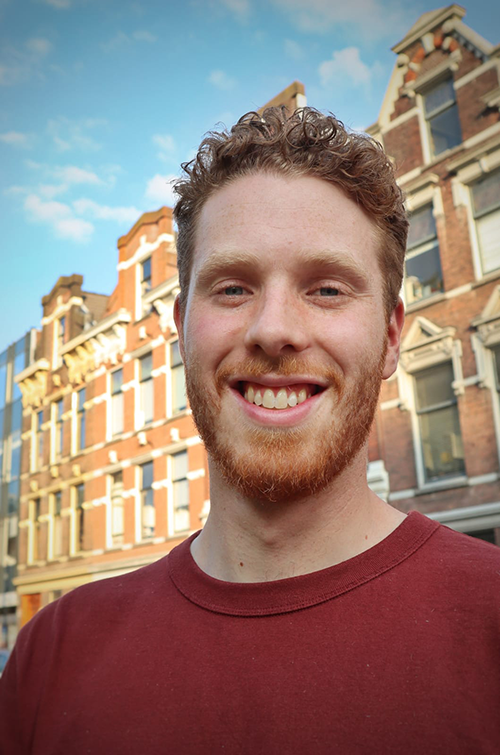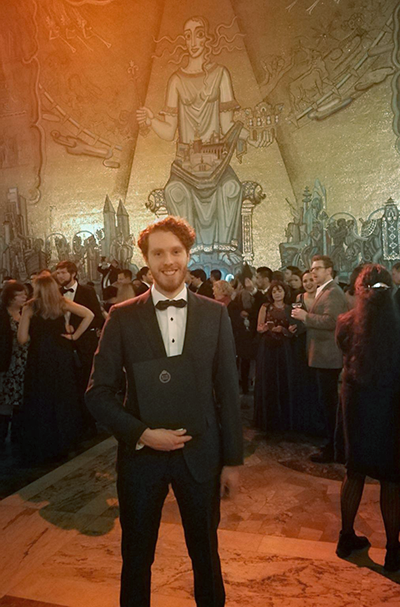Yuri helps with creating a new strategic vision for the urban development of The Hague
Yuri Impens graduated from the master’s programme in Sustainable Urban Planning and Design in 2017. He now works for the City of The Hague in Programme Management, Strategy and Research.

Hi Yuri, where are you working at the moment?
At the moment, I am working for the City of The Hague, the third city of The Netherlands and the Royal Residence and seat of the Dutch Parliament. More than 7,500 people are working for the City to make sure all of the municipality’s jobs are carried out in a good way. I work for the ‘Dienst Stedelijke Ontwikkeling’, literally translated to the ‘Service of Urban Development’, together with around 800 colleagues. Together with 25 people, I work for the department of Programme Management, Strategy and Research.
In my department, my tasks are quite broad: I work on implementing a new programme management method called Management of Portfolios, which aims to improve the overview and analysis of all urban development projects in the city. Besides that, I also help with creating a new strategic vision for the urban development of The Hague, and I work very specifically in a few neighbourhoods on activating places and the people that use those on a daily basis, which are examples of placemaking.
Have you worked with anything else since you graduated?
Placemaking was front and center in my degree project, internship and, thereafter, my first job at STIPO, a Dutch company based in Rotterdam but also working internationally, mainly in Greece and Stockholm. I wrote my thesis about the public space in and around covered food halls, and the organizations that created the food halls and public spaces. After my internship, during which I was based in Rotterdam, I moved back to Stockholm to work with STIPO on projects in Stockholm, such as a research to the possible temporary use of office buildings in Sundbyberg. I also organised a two-day conference in 2018 called “Cities for All”, where more than 200 international people working with urban development and placemaking came together to talk about how placemaking can play a role in creating inclusive cities.
What can a regular day look like at your job?
A typical day at my job would be arriving at 08.30 and starting the day by going through e-mails and updates since the previous day. On Tuesday mornings, we have a 15-minute update with the whole department about important developments within our work environment. After these moments, I usually spend some time working on my projects on my computer, as well as having a few meetings a day to discuss these projects. For lunch, I like to go outside with my colleagues to stretch our legs a bit during a lunch walk.
Why did you choose this programme at KTH?
I chose the programme in Sustainable Urban Planning and Design for several reasons. The fact that the programme offered a two-year (instead of one) education on sustainable urban development was very important to me, because it meant I could develop myself both on this subject in a general way as well as being able to choose which specific subjects I wanted further education. Besides that, KTH seemed like a very good and internationally-oriented university. I did my bachelor’s degree at the very human sciences-oriented University of Nijmegen (in The Netherlands), so I was interested in studying urban development at a university with a more technical approach. Finally, the prospect of getting to spend so much time abroad, in a great city like Stockholm, was very exciting to me. I had already previously done an exchange semester in Bergen, Norway, so I was excited to go back to the North to discover it more.

What was the best aspect of your studies at KTH?
For me, the most valuable part was getting to be in class with so many Swedish and international students, who all had different backgrounds and approaches to the subjects and assignment we got to work with during our programme. It was great to get to learn about different cultures, getting to share ideas on urban development and work in teams with people with different disciplines. Of course, getting to socialise and meet other people outside of our own programme was great too, and KTH offers many possibilities to get in touch with other students, get active in the student life or simply enjoy the parties and events set up by the university.
What is your best memory from your time at the university?
It is hard to just pick one, but if I have to choose, I would say that my trip to Lappland in December 2015 was the best. We went on student-organised trip, with lots of other students from KTH and other universities in Stockholm and Uppsala, and had a really special time. We saw the northern lights three times, went dog-sledging and snow-scooter driving and took a midnight swim in a nearly-frozen lake after we went to the sauna. These are memories that I will never forget.
What are your plans for the future?
For now, I am happy at my current working place, and I hope to develop myself further here. However, I really do miss Stockholm and my friends there, so I’ll always keep an eye open for opportunities there.
What would you want to say to a student thinking of applying for this programme?
Make sure you make use of the possiblity to develop yourself in different topics and themes, as the programme structure gives you the opportunity to do so. Something that I really enjoyed and found useful was to also take Swedish courses at KTH. Besides the programme, I would recommend to make the most of your time in Stockholm by joining activities or becoming active in organisations, and to travel around to discover what’s beyond KTH and Stockholm.